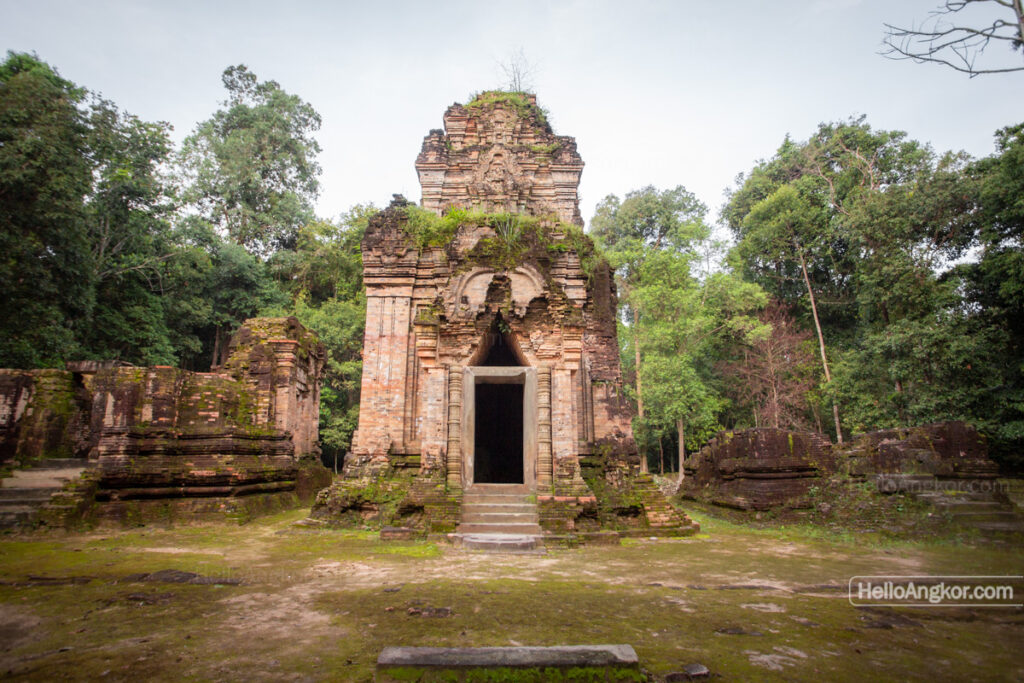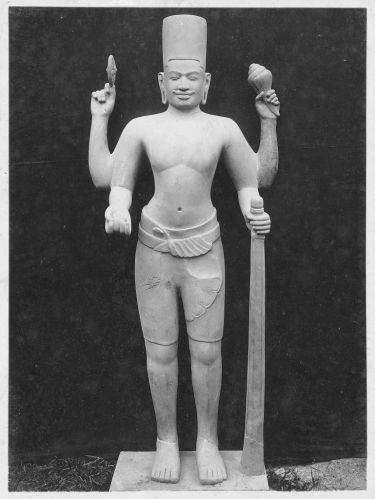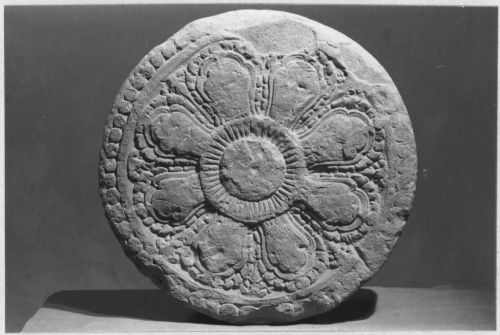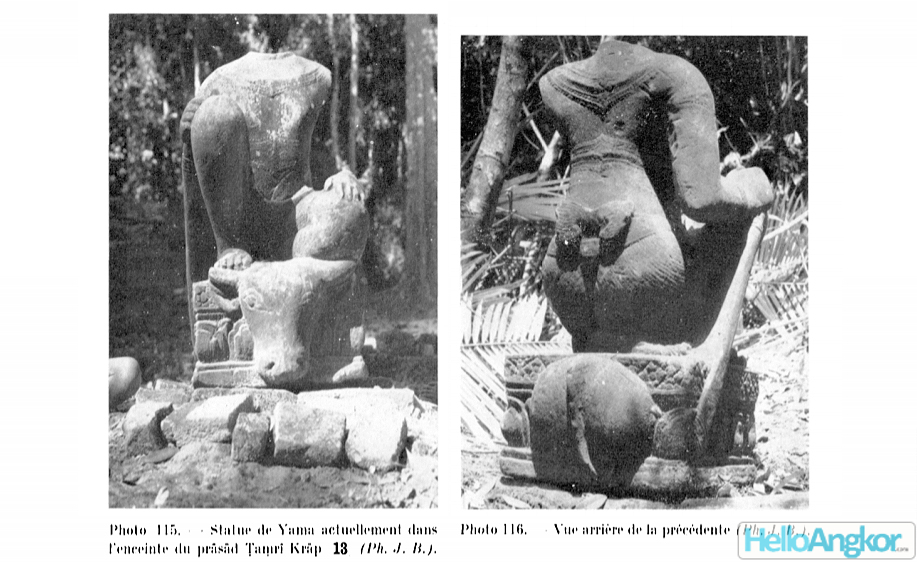Also known as Damrei Krab Temple (ប្រាសាទដំរីក្រាប) and Prasat Prasat Krabei Krab (Khmer: ប្រាសាទក្របីក្រាប). A group of three brick temples, aligned on a north-south axis and opening to the east. The central tower is in good condition (restored in recent times) and the side towers only partially standing. The site is further surrounded by remnants of an outer wall with a gopura on the east. It is believed to date to the 8-9th century based on its style as no inscription has been discovered to date.
The artwork and carvings on the central tower are truly wonderful making it well worth the effort to visit. The central tower retains its three upper false levels which is incredibly rare for a brick tower of this era.
The tower’s architectural style is somewhat unique to Kulen when paying attention to its narrow stance, which continues in its upper levels. The cornice line is enhanced by the flared pilaster capitals which give support to the mini-prasats that sit at each corner of the level above. A short forebody with embossed pilasters accentuates the false doors and entrance. The entrance door is flanked by beautifully decorated sandstone colonettes that would have been topped by a decorated sandstone lintel as seen in historical images. The pediment that rises above is also unique to the era, the main pediment could be seen to draw from prior styles, while the upper pediments may well have influenced those of later eras. The niches of the pediments are inset with characters, and above the main entrance, it featured Brahma flanked by two kneeling worshippers according to historical images.
Photos 2024









Inside the central tower, a trio of interesting niches can be seen in each of the walls variations of which are seen in some other pre-Angkorian brick temples, along with fragments of a sandstone decorative lintel (see historical images), and a spouted pedestal.



Photos 2021








Getting There
Damrei Krap is located atop the southeastern side of Phnom Kulen south of the village of Anlong Thom on a trail that leads past several other sites and onwards to Srah Damrei. The trail is suitable for walking/hiking and for trail bikes. It can be quite eroded in places and flooded in parts after rain. It’s recommended that visitors who are not familiar with the trails of Phnom Kulen National Park should contact Anlong Thom CBTC for a guided tour.
Starting from and returning to the main road, visiting all the sites along this trail section can take around a half day or more by moto.
Historical Notes
The site was first documented in the early 1900s by Lunet Lajonquiere, followed by a string of veritable researchers through the mid-to-late 1900s including Marchal, Stern, Remusat, Dupont, Parmentier, and Boisselier to name some.
A statue of Vishnu was recorded by Victor Goloubew in 1924 and during excavations at the site in 1935, its base and various fragments of the arms and legs, of two of the hands holding respectively a ball and the handle of a club were discovered. The statue is now on display in the Phnom Penh National Museum. Later, in the 1930s, the statue played an important role in Phillipe Stern’s creation of a chronology of art styles and the definition of the Kulen style.
PRASAT DAMREI KRAP. The same architectural tradition can be studied on three other towers known as Prasat Damrei Krap (Temple of the Crouching Elephant). They are located an hour and a half walk south-southwest of the village of Anlong Thom where four straw sálás have been recently installed by the delegate of Siem Reap.
The three towers half disappear behind the trees; it was necessary to carry out a summary clearing in order to be able to examine and photograph the primitive style sculptures which constitute their decoration. Inside the central temple are the remains of a beautiful human-sized Brahmanic statue, representing a standing god, with two pairs of arms. The modeling is remarkable; as it is, despite its poor state of conservation, this sculpture deserves a place of honor in the Albert Sarraut Museum. The absence of the head and hands does not allow the god to be identified. According to the locals, it would be a Vishnu.
There are other brick towers in Phnom Kulen belonging to the primitive period, among which the most important are the Prasat Andong whose construction had been wrongly attributed to the Chams, and the Prasat Neak Ta located near Anlong Thom, not far from the path which descends towards Beng Mealea.
Le Phnom Kulen, Victor Goloubew, 1924
In 1927, Henri Parmentier wrote a lengthy introduction to the architecture of the site in L’art Khmer Primitif noting the style being reminiscent of Cham art and in particular the Hoa Lai Tower.
Historical Images
Images via EFEO Fonds Cambodge, more can be found here. The first image in the set, the restored statue of Vishnu, is on display at the Phnom Penh National Museum.









Images of Yama on his buffalo recorded at Damrei Krap in Bhnam Gulen, Boulbet/Dagens, 1973

Map
Site Info
- Site Name: Damrei Krap (Pr.) Khmer Name: បា្រសាទដំរីក្រាប
- Reference ID: HA11744 | Last Update: October 19th, 2024
- Other Names: Damrei Krab Temple, Prasad Tamri Krap, Prasat Krabey Krab, ប្រាសាទក្របីក្រាប
- Date/Era: 9th Century
- Tags/Group: a, Kulen, Map: Top 100 Temples & Ancient Sites (Siem Reap), Phnom Kulen, pr, T25, Temples
- Location: Siem Reap Province > Svay Leu District > Khnang Phnum Commune > Anlong Thom Village
- MoCFA ID: 461
- IK Number: 558
- Credits: Thanks goes to Lim Theng Hak for the locally used name: ប្រាសាទក្របីក្រាប

